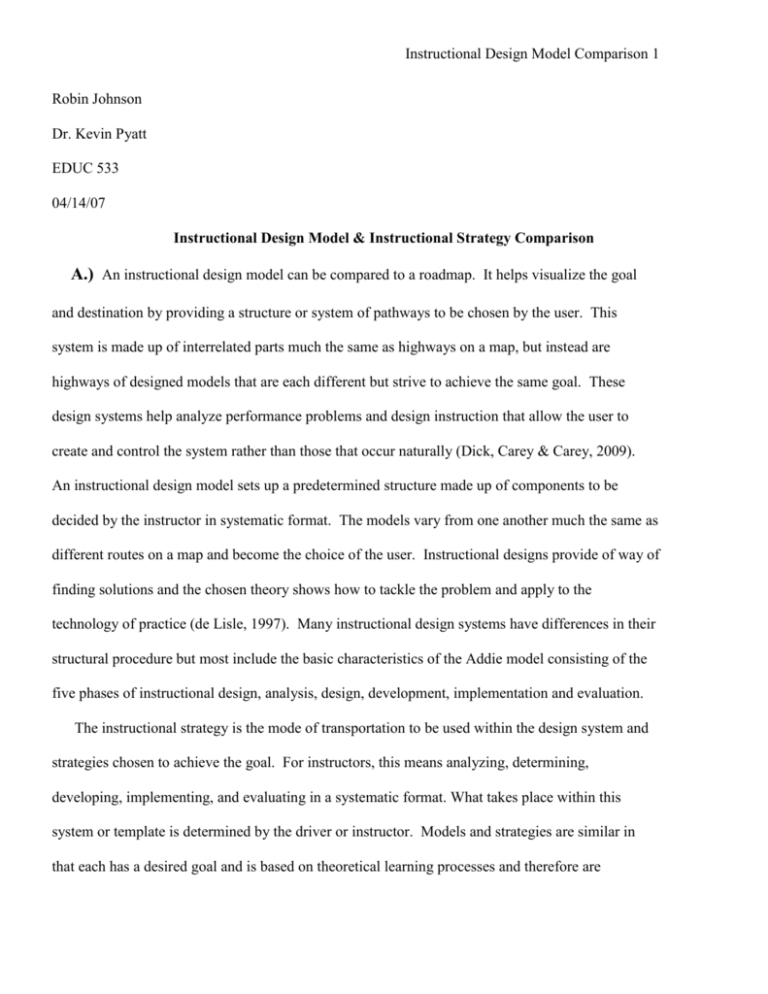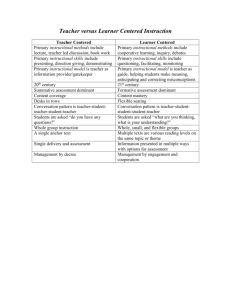Instructional Design Models Comparison
advertisement

Instructional Design Model Comparison 1 Robin Johnson Dr. Kevin Pyatt EDUC 533 04/14/07 Instructional Design Model & Instructional Strategy Comparison A.) An instructional design model can be compared to a roadmap. It helps visualize the goal and destination by providing a structure or system of pathways to be chosen by the user. This system is made up of interrelated parts much the same as highways on a map, but instead are highways of designed models that are each different but strive to achieve the same goal. These design systems help analyze performance problems and design instruction that allow the user to create and control the system rather than those that occur naturally (Dick, Carey & Carey, 2009). An instructional design model sets up a predetermined structure made up of components to be decided by the instructor in systematic format. The models vary from one another much the same as different routes on a map and become the choice of the user. Instructional designs provide of way of finding solutions and the chosen theory shows how to tackle the problem and apply to the technology of practice (de Lisle, 1997). Many instructional design systems have differences in their structural procedure but most include the basic characteristics of the Addie model consisting of the five phases of instructional design, analysis, design, development, implementation and evaluation. The instructional strategy is the mode of transportation to be used within the design system and strategies chosen to achieve the goal. For instructors, this means analyzing, determining, developing, implementing, and evaluating in a systematic format. What takes place within this system or template is determined by the driver or instructor. Models and strategies are similar in that each has a desired goal and is based on theoretical learning processes and therefore are Instructional Design Model Comparison 2 instrumental to one another in achieving these goals. The instructional design model serves only as a map or blueprint whereas instructional strategy is flexible, capable of revision and change as it works within the instructional design model. Each serve the same goal or purpose but have different modes of operation; one is static and the other is dynamic. The instructional design provides a structure of components such as in the Dick and Carey Systems Approach. This systematic linear pattern follows nine sequences of components starting with identifying instruction goals and ending with conducting summative evaluation. Revision and change is dependent on the feedback from each component. This linear process is helpful because it brings together one coherent whole of many concepts, however, some considers this system as inflexible and assumes human behavior in instructional situations is predictable (Winn, 1997). In contrast, instructional designs such as Bloom’s Taxonomy are circular and show a continuous improvement model that is useful where planning, development, implementation and revision all occur at the same time or in multiple cycles (Dick, Carey & Carey, 2009). What is important is that instructional design models may be different in structure but each is instrumental in the navigation of developmental pathways where disciplines are mastered by acquiring certain skills and competencies through practice and not from emulating the model itself (Senge, 1990), therefore, serve as a useful tools in the providing a navigational map of learning in which instructional strategies flow and travel. B.) Instructional Design Model Comparison 3 Dick & Carey Model A D D I E Blooms Taxonomy Identify and conduct instructional goals and analysis, and identify entry behaviors Analysis: Separates material or concepts into component parts so that its organizational structure may be understood such as appraising, calculating, comparing, contrasts, criticizing, differentiate, distinguish, examine, experiment and questioning. Write performance objectives, develop Synthesis: builds a structure or pattern from criterion referenced tests, and develop diverse elements. Puts parts together to form instructional strategy. a whole with emphasis on creating new meaning. Develop and design instructional Cognitive: first one must be mastered materials and design conduct before the second one can take place. formative evaluation. Knowledge & Comprehension: arrange, define, duplicate, label, list, memorize, name, order, recognize, reproduce state, retell, select, explain, discuss, describe. Implementation is not included as a Applies to what was learned in the separate step. Implementation occurs classroom into novel situations, experience, during design and development. problem solving, use of facts and rules, and applying information to produce some result. Design and conduct summative Make judgments about the value of ideas evaluation. and material and their progression in learning. The Dick & Carey model works well when focusing or targeting a specific age group as in K-12 but can be easily adjusted to adapt to other age groups or classrooms depending on the subject. It also seems able to target and trouble shooting key areas needed for development such as an older person returning to school and needing to refresh their skills. This would make sense for an interdisciplinary class meant to build up skills and expose the student to a variety of college expectation whereas the Bloom’s taxonomy is based more on three areas of learning. These three areas of learning are cognitive, affective and psychomotor. Memorizing and learning rules are important in Bloom’s taxonomy but how to approach this will be unique. Bloom’s taxonomy is a type of analytic model in search of the most effective design to incorporate instructional strategies bringing these three learning applications together. The Bloom’s Taxonomy model could work within a number of system models with a vast area covering instructional strategies. This model works within a step by step system weaving in and out of different criteria. The Understanding by Design would seem suitable for this taxonomy but the Dick and Carey model would seem ideal for the systematic process of step by step instruction. The Dick and Carey model is considered a prescriptive model while the Bloom’s Taxonomy is considered to be a modern model under objective taxonomies. C.) Instructional Design Model Comparison 4 ANDROGOGY MODEL PROBLEM-BASED LEARNING Problem solving & Technology based learning Teacher as Facilitator and guide Elaboration of prior knowledge & processing of new Student Centered Andragogy Lifetime experiences: Case studies, narratives, & reflection Social interaction in small collaborative groups Flexibility in design and moving students from old to new information Comparison Criteria Student Centered Assessment 21st Century Small open ended problems that become more complex resolution and Inquiry based learning, skills and scaffolding. Feedback and Reflection of learning that has taken place Model 1 Model 2 Student centered because these students carry lifetime experiences and have additional base knowledge that can and should be used. Individual reflection, observation of power and responsibilities, and the changing nature of class progress after. Student centered where they collaboratively solve problems and reflect on their experiences and new experiences learned. Technology based instruction and move through sequence of need to know information and pace. Feedback and refection of what has taken place. Working from simple to complex with evidence of improvement of analytical, technical and or critical thinking skills Actively problem solving that help in working memory limitations; learning to learn processes fluencies Ease of Use Depends on instructor’s use of facilitation, implementation of strategies for subject matter, and careful consideration of time limits and assessments. Guidance of learning processes rather than to provide knowledge. knowledge Instructional Design Model Comparison 5 These two models work together well since an older adult will utilize their past experience based knowledge to learn and grow. The Problem-based Learning model is designed with this purpose in mind. It also uses problems solving for the adult learner to learn new information and compare with old information. An example of this is past biases and learning different points of view through small groups. Adult learners are used to understanding what they do in life and need to know the reason they are learning something new and how it applies or will benefit them. Adult learners are problem-centered in their orientation of learning and like real life examples. Problem based learning is a good instructional strategy that would work well in Understanding by Design for the adult learner; however, there are other important strategies that should need to be considered and implemented such as technical based learning.






